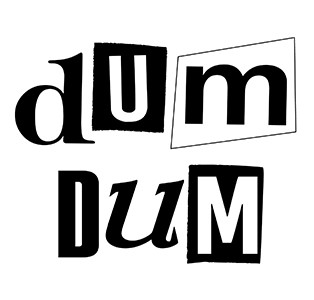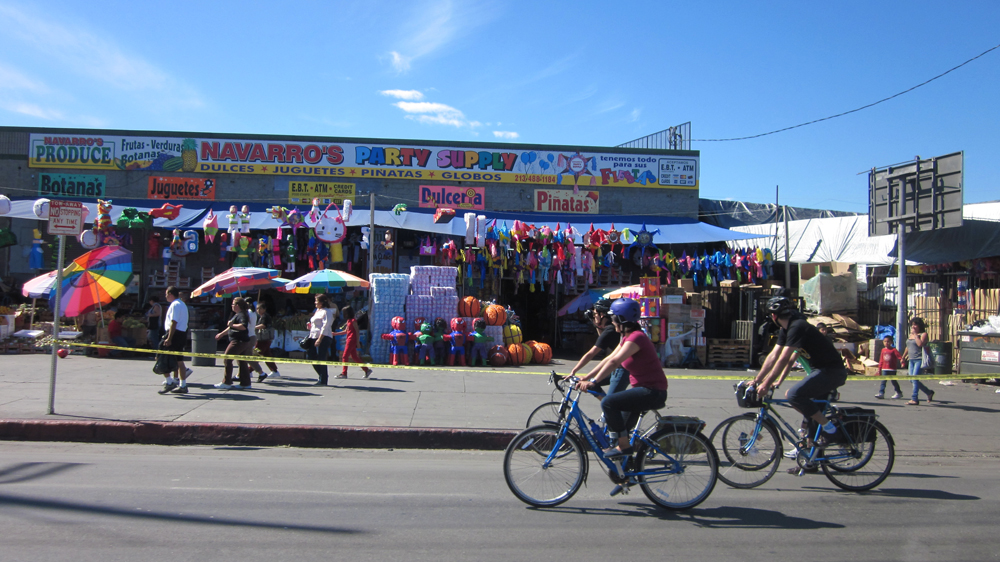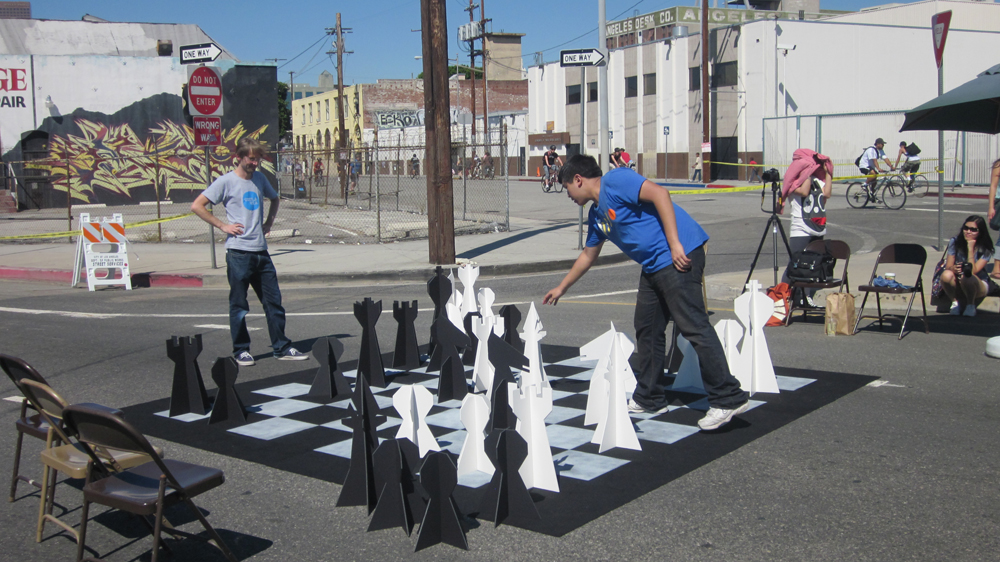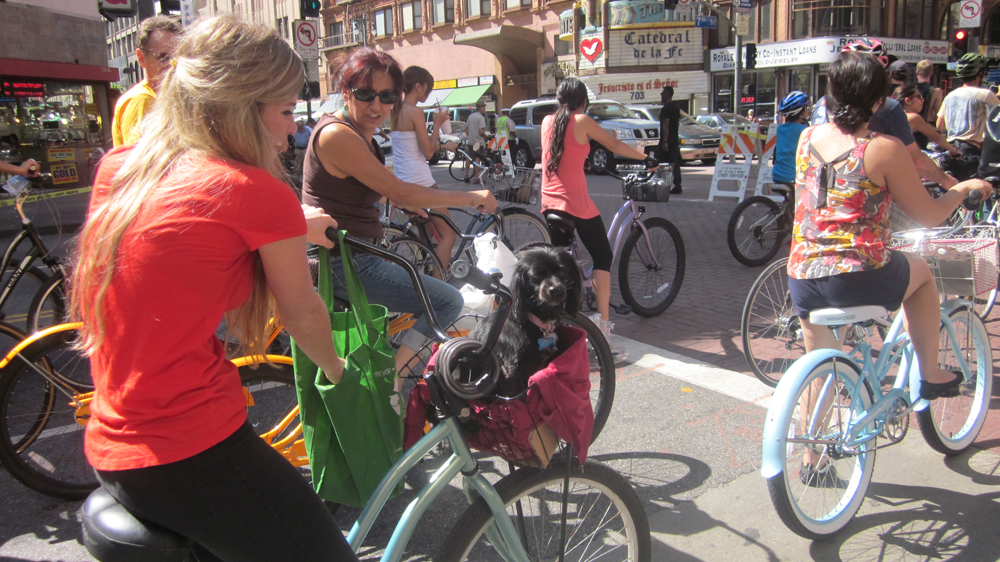CicLAvia: Cycling Through Unoccupied Streets Travis Barnes
It’s an eerie feeling–dropping down on your bike into a busy intersection near Wilshire and Vermont midmorning and finding yourself without a car in sight, their honks and screeches replaced by bicycle freewheel ticks and children playing. Recall the end of that Zombie flick, where the abandoned skyscrapers and streets form desolate steel and concrete canyons. Now imagine that stark landscape repopulated by survivors,the scene in the credits when the adult survivors run and jump back out in the forbidden open areas, enjoying with childlike simplicity the shell of their former civilization.
That’s exactly what it feels like to arrive at L.A.’s CicLAvia before it gets going in earnest. The beautiful event, in which 10 miles of streets in Los Angeles are closed down to cars so that bikes can rule the streets, originated in Bógota, Colombia, where people spill onto the streets on bicycle, fair games, stunts, and street theater until cars roll back in the early afternoon. Sunday’s event was the third time the event has taken place in our fair city, and promoters this time expanded the route from the original transect from Echo Park to Boyle Heights to include South L.A. and Alvarado Street.
Everybody is the kind of nice that your mother told you to be suspicious of. Cops loiter on their bicycles by the side of the road, shooting the shit. It’s as if Main Street, U.S.A. moved to MacArthur Park for the day just to mess with everybody. By the time the event was in full swing, Downtown was bustling with bicycles which probably outnumbered the cars that typically congest the streets. Spread out before the eye are on Spring Street are bicycles as far as the eye could see, and if you looked through the right spirit, you’d be tempted to say that a revolution was in progress–bike-mounted Angelenos taking their city back by force.
But which Angelenos, and from whom? There are countless class tensions inherent in the event which implicitly aims to the Bourgeois commuters out of their cars and into the streets of South L.A., Boyle Heights, and MacArthur Park. I was a little on edge myself as I saw grizzled Midnite Riderz weaving their industrial fixies through streets teeming with local Hispanic kids on training wheels and Santa Monica moms pushing babies in strollers, all under the addled supervision of homeless regulars. But aside from a few off-color remarks (at the end of the event, as six white college kids refused to move to allow cars through I heard one woman shout, “Go back home, you rich yuppies!”) everyone brokered an easy peace because ultimately, everyone was out to enjoy the same novelty street fair on a beautiful sunny day. In fact, for the most part everybody relished the experience of a new neighborhood and culture. In Boyle Heights, for example, a Peruvian string and dance ensemble performed in the park, while a rapper and reggae band performed on different stretches of the South L.A. stretch. Occupy L.A. protesters hosted political speeches on a stage across from their campground at City Hall, from whose steps you could still hear the corridos off Alvarado.
I would be remiss to call this the real L.A. This was L.A. in a parallel universe without the single factor that had made it what it was: the automobile. Just being able to stand in the middle of Vermont Avenue and admire the unexpected Art Deco architecture of a Bowling alley puts you outside of reality. It was Heisenberg’s uncertainty principle in action: we had to shut down the entire pulse of the city to see what lay at its artery walls. This was at once its own unique landscape and soundscape. Riding a bike through the crowd you were likely to hear snippets of conversation both from people enjoying a daily physical activity as well as those who may very well never have touched a bicycle. “Why’s it so hard on the hills?” one woman wailed. Her companion yelled back, “You have to shift down, twist backwards!” “Which side!” “I don’t know!” The unfortunate cyclist was pushing her bike a moment later by the end of the exchange. I overhear, at a Coca-Cola tasting booth, two middle-aged riders in full latex discussed the merit of their tea-lemonade infusion–“It’s underwhelming… but in the best way.”
There were countless activists along the route, making a political buffet of causes for the weekend warrior. There were organic foodies passing out orange samples on one corner while the singer of a performing neo-soul band passed out kisses on the cheek and cards promoting disastrous earthquake awareness: “Please store water in a car, at work, at home and get to know your neighbor before the Big One Earthquake. H20+XO.” Then of course, there was the pan-activist Occupy L.A., whose hard-core participants, bizarrely, were too tired to participate, and not so bizarrely, totally at odds with the happy-go-lucky riders out. I’d say that far from representing any kind of angry activism or agenda, even pro-transportation. They resist resistance by having fun, making a playground of the streets of a city that politicians, activists and business leaders agree is a wasteland. And when 3pm hit and the streets they dissipated in every direction, leaving no record of their numbers, force or ideology. CicLAvia was a private revolution of fun, a street party for every type of person who’d never get caught dead in company to ride around the block together. Don’t make it anything more. You couldn’t ask for more.
All photographs by Travis Barnes.
Monday, October 10, 2011









